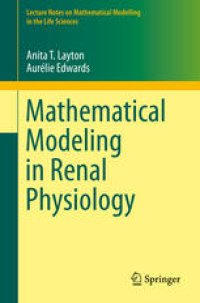
Ebook: Mathematical Modeling in Renal Physiology
- Tags: Physiological Cellular and Medical Topics, Mathematical and Computational Biology
- Series: Lecture Notes on Mathematical Modelling in the Life Sciences
- Year: 2014
- Publisher: Springer-Verlag Berlin Heidelberg
- Edition: 1
- Language: English
- pdf
With the availability of high speed computers and advances in computational techniques, the application of mathematical modeling to biological systems is expanding. This comprehensive and richly illustrated volume provides up-to-date, wide-ranging material on the mathematical modeling of kidney physiology, including clinical data analysis and practice exercises. Basic concepts and modeling techniques introduced in this volume can be applied to other areas (or organs) of physiology.
The models presented describe the main homeostatic functions performed by the kidney, including blood filtration, excretion of water and salt, maintenance of electrolyte balance and regulation of blood pressure. Each chapter includes an introduction to the basic relevant physiology, a derivation of the essential conservation equations and then a discussion of a series of mathematical models, with increasing level of complexity.
This volume will be of interest to biological and mathematical scientists, as well as physiologists and nephrologists, who would like an introduction to mathematical techniques that can be applied to renal transport and function. The material is written for students who have had college-level calculus, but can be used in modeling courses in applied mathematics at all levels through early graduate courses.
This comprehensive and richly illustrated volume provides up-to-date, wide-ranging material on the mathematical modeling of kidney physiology, including clinical data analysis and practice exercises. Basic concepts and modeling techniques introduced in this volume can be applied to other areas (or organs) of physiology.
With the availability of high speed computers and advances in computational techniques, the application of mathematical modeling to biological systems is expanding. The models presented in this book describe the main homeostatic functions performed by the kidney, including blood filtration, excretion of water and salt, maintenance of electrolyte balance, and regulation of blood pressure. Each chapter includes an introduction to the basic relevant physiology, a derivation of the essential conservation equations, and then a discussion of a series of mathematical models, with increasing level of complexity.
This volume will be of interest to biological and mathematical scientists, as well as physiologists and nephrologists, who would like an introduction to mathematical techniques that can be applied to renal transport and function. The material is written for students who have had college-level calculus, but can be used in modeling courses in applied mathematics at all levels through early graduate courses.
Anita T. Layton is the Robert R. and Katherine B. Penn Associate Professor of Mathematics at Duke University.
Aurélie Edwards is director of the Laboratory of Renal Physiology at the Cordeliers Research Center in Paris, in affiliation with the French National Center for Scientific Research (CNRS).